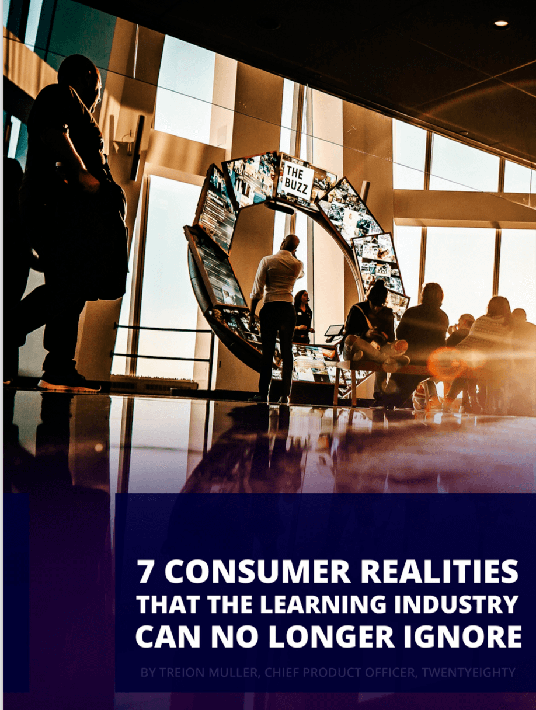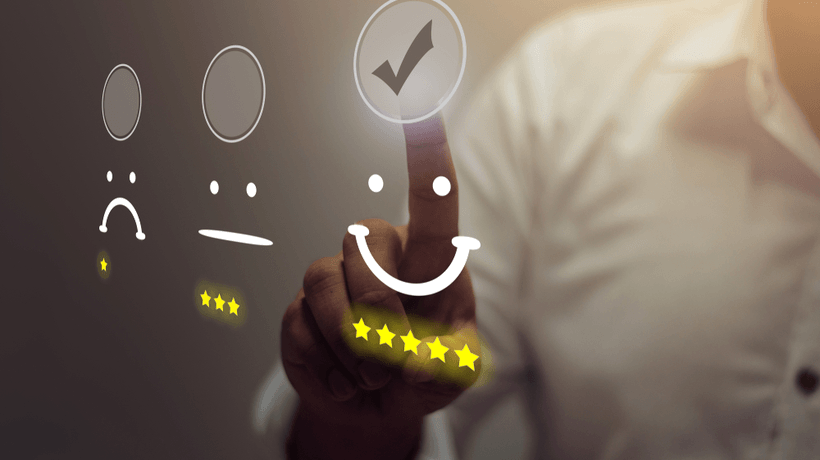What Consumers Of Learning Want (Part 3): The Last 2 Consumer Realities
So far in the series, I have suggested that we live two lives when it comes to how we consume information. In our personal lives, we enjoy and engage in the moment answers to our learning questions, while at work we typically have to sign up for an in-person workshop a month from now or attend an arbitrary one-hour webinar. As consumers of information, we prefer the latter. We want answers to our professional questions or challenges at the moment we need them (see Part 1). I have also introduced the first 5 of 7 consumer realities that the Learning and Development industry can no longer ignore (see Part 2).

In this last article of the series, I’ll share the remaining 2 realities: "I want to be entertained!" and "I want the same at work!"
6. I Want To Entertained!
The Leichtman Research Group estimates that 54% of American adults have access to Netflix in their homes. I’m no math whiz, but even I can deduce that this is more than half of the US population. That number says it all. There is no additional evidence needed… except that there is still 46% of the US population that doesn’t subscribe to Netflix yet, which is why Netflix plans to invest roughly $1 billion into its marketing efforts in 2017– up from $842.4 million last year.
In addition, Netflix will be spending $6 billion[1] on new content this year. I’m pretty sure that most fortune 500 companies would be thrilled just to bring in $1 billion in revenue, but Netflix is actually spending that amount to try and keep the 54% and get more of the 46%. Don’t forget YouTube! With 1 Billion hours of videos watched daily, there is no question how consumers like to be entertained. Entertainment = power and money. Pandora[2] has concluded that the average American listens to about 4 hours of content per day.
So, if Americans are not watching something, it’s likely that they’re listening to something. Yes, today’s consumer loves to be entertained. So much so that we tune in, plug in, turn on, whenever we have a spare moment, and often when we don’t… like while at work. What are we in L&D doing about it?
7. I Want The Same At Work!
Now that you’ve been blasted with six consumer sentiments, there is one more behavior that incorporates everything else we’ve just covered, and it this - I want the same at work!
Your learner and a modern-day consumer are one and the same, and they expect the same behaviors from their work environment as they do from their personal lives. The Boston Consulting Group supports this assertion[3], “B2B customers today expect…the same digital experiences and features that they encounter as consumers.”
In another study[4], this argument was made very clear when a whopping 93% of over 5,000 people surveyed expresses the desire to integrate learning and work. A number that’s jumped from 80% in 2015. In other words, we don’t want live separate lives anymore.
However, whenever you have to deal with an established industry with entrenched routines, protocols, and expectations like the Learning and Development space, change means growing pains. Having worked in the L&D space for over a dozen years now, I understand that adjusting the course of his huge ship is not going to happen overnight. Especially when some at the helm of that ship do not want to change direction. There will be growing pains. If you think about it, Learning and Development has been done a certain way for decades – maybe even hundreds of years. On the other hand, digital innovation over the past ten years has led to the new consumer behaviors we’ve discussed and those we have yet to discover. With these two opposing viewpoints—traditional training conditioning and new consumer behavior—it’s no wonder there are so many challenges to face.
As I’ve worked with some of the biggest companies in the L&D world, I have come to realize that the most common obstacles to change can be lumped into 4 categories:
1. The Secret Sauce Protectors
2. The Sage on the Stage
3. The Sales and Product Development Conflict
4. The Traditionalist Buyer
The Secret Sauce Protectors
Subject Matter Experts (SMEs) come in different forms - authors, content experts, company executives, and seasoned facilitators. Each have years and years of experience with content or intellectual property (IP). Most have had life-changing experiences associated with the IP and have seen that same IP change the lives of countless others. Because of these compounding experiences over decades of instruction, they have come to view the principles they have taught, or written or sold, as sacrosanct. They have emerged as the keepers of the content or the Secret Sauce Protectors. To them, there is an ideal way, a special sequence, a tried and true approach to teaching the IP they live and breathe. Something that has been molded over many years of trial, failure, and testing. So, it’s no wonder that when the new “thing” comes along, they’re averse to change.
The truth is, these traditional, proven approaches still work! They still change paradigms. They still change lives. And they still will and should for many years to come. Instructor-Led Training (ILT) is NOT dead. This is NOT an “OR” argument, where the implication is that we need to replace ILT with new consumer-driven digital modalities. This is an “AND” strategy where L&D companies should continue practicing some of the proven training approaches they’ve implemented for decades AND look for new ways of addressing the 7 Consumer realities we’ve discussed. In regard to this “AND Strategy”, Bain and Co., in their “Digital Strategy for a B2B World” report suggest the following approach:
“When it comes to strategy development, most leadership teams have both doers and dreamers. Doers are focused on the here and now. They want to cut through the digital hype and direct the company’s energy toward implementing practical digital initiatives. The dreamers tend to focus on the long term. They want to define the full set of ways digital could either evaporate the company’s profit pools or create new opportunities to become the disrupter. Both perspectives are critical because both are valid. Yet when these two groups are left in opposition, the tension can be paralyzing. An effective strategy-development process resolves these conflicts by striking a balance between the doer and dreamer perspectives. It should blend a practical set of near-term, high-impact initiatives with a bold vision for how the pace of digital innovation is likely to reshape the industry over time. Customers who have grown accustomed to flawless online experiences in their personal lives expect nothing less in their business relationships.” (Bain & Company - “Digital Strategy for a B2B World)
In summary, to find the resolution to this stalemate between the Secret Sauce Protectors and innovative digital alternatives, we must work together on short-and long-term roadmaps that take the best from the past and the present into consideration. We must simultaneously embrace the Secret Sauce Police and their relevant experience and educate them on the new opportunities and modalities. There is power in diversity and in complementary strengths and experiences.
The Sage Of The Stage
In the past, the Sage on the Stage possessed all the power to unlock the information necessary for a learner to gain a particular skill. That is no longer the case. Today, the community is the new expert. If you or I have a dilemma, a question, or a work problem, we simply ask the community—of which Google is the all-knowing gatekeeper—and receive a wealth of answers from a breadth of sources. This goes back to our first consumer reality where we want answers now, and we know that somewhere in the world-wide ether there exists someone, or some database, that has the answer.
The challenge some companies face is a well-known one. The Sage on the Stage is not ready to give up his or her role or share the stage with a community of other experts and bots. To overcome this challenge, we must encourage inclusion and curation over lecture and control. If those Sages would agree to morph into facilitators and curators of knowledge instead of taking on the insurmountable task of being the keeper of all knowledge, they could help unlock the secrets of the digital age and allow their learners (aka consumers) to discover information and even share with their own company community of practice. This one shift alone will move companies from being stagnant oligarchies to thriving learning environments.
The Sales And Product Development Conflict
There is an ongoing conflict between two factions in most companies – sales and development. To understand how this conflict impacts moving to new digital models and applying consumer behavior in our training products, we must first take a look at what we mean by “clients” or consumers.” (This challenge only applies if you sell your training products to a client or customer. If this is not you, jump on over to the next challenge.)
When we talk of clients, we have to keep in mind that we often have more than one customer or target audience that we are trying to influence and reach, which provides an interesting challenge and subsequent conundrum. The typical clients that L&D targets are:
- The Buyer
The buyer is understandably any "for profit" organization’s most important customer. These are the gatekeepers, the decision-makers whose opinions matter to a sales-driven company. They control the purse strings. They try to see the big picture. They believe they understand the jobs to be done. We’ll talk more about them in the fourth and final challenge. - The End User
This is, in essence, the “real” client. Development teams build products to impact the individual and help them apply principles of effectiveness. To use common training jargon—to change behavior. End users want to be engaged, inspired, and entertained. They do not care about how much a course costs, as long as it is accessible in the moment of need, that it‘s short, entertaining enough to keep their attention, and relevant to their specific professional needs. You see, they have a job to do, and limited time to do it. So, the unique challenge we have when building any training products is balancing the wants and needs of our two different customers—the buyer who hands over the money, and the end user who actually decides whether that training works for them or not. Along with two client personas, we also have two opposing company (L&D) personas – sales and development.
- From an Instructional Design or development perspective, those involved want to create a product that changes behavior at the end-user level. They believe that content should dictate the length of a course because that is good, sound adult learning theory. They don’t like to be forced into arbitrary time blocks for the sake of consistency. For the most part, they are in alignment with the end users.
- From a sales perspective, those involved may also want what my ISD wants, because it means they have a good product to sell, but they care more about how easy that product is to sell to the buyer. They are the top priority, not necessarily the end user. Sales want neat packages, with uniform lengths, clean numbers, and simple messaging. Their goal is to sell as much as possible. For the most part, they are aligned with the buyer.
Now you can see why these two key company personas are often at odds over what the right training solution is. Paradoxically, both are right. Both want what’s good for the company. One is governed by customer-centric principles, while the other is governed by sales revenue and the survival of the company. Since revenue is the lifeblood of any company, sales will usually triumph over Instructional Design in a head-to-head battle on what’s best for the company.
While this submissive acquiescence to sales may lead to decent training products, what we fail to see is how much better those products could have been if they were built upon customer-centric principles, as well as sales-centric goals. The marriage of these two factions may seem unlikely, but it’s not only possible—it is necessary for survival. With a unified front to the client buyers, revenue will inevitably grow, and at a much greater pace than before, because solutions are grounded on both adult learning theory and best practice and sales best practice.
Plus, buyers who perceive solutions as not only doing the job they were hired to do but that also engage and entertain, will be more likely to buy more products in the future. After all, it makes them look good to the end users and their bosses.
The Traditionalist Buyer
The Traditionalist Buyer is usually the ultimate L&D or Talent Management decision maker. They are the gatekeeper who decides what training comes into their company and in what form it will be consumed. A buyer of L&D in any company has one of the toughest jobs.
They have diminishing training budgets to juggle, emerging leaders to train, distributed workforces to manage, a variety of generations to please, competencies to meet, and ROI to measure. The challenge with the Traditionalist Buyer is not they don’t understand the value and relevance of the 7 Consumer Realities. The challenge they face is that IF they make changes to their L&D, they have to figure out how to manage all the moving parts it impacts, not to mention getting buy-in from the Secret Sauce Protectors and the Sages of the Stage. Plus, unless they have been intimately involved in understanding this radical consumer behavioral shift, they may be out of touch with what to do. They may still be relying on their decades’ worth of knowledge and experience which centers on live, in-person training.
For the Traditionalist Buyer to be able to move to consumer-focused L&D in their companies, they may need help with what to do and how to educate the other gatekeepers and decision-makers on the 7 Consumer Behaviors and how they impact their company. This will not be an easy task, but Traditionalist Buyer could start by taking the following Reality Assessment and then deciding which areas to work on next:
Consumer Reality Assessment
So, take a moment to ask yourself the following seven questions about your company's L&D offerings:
- Can your learners easily access answers to their JIT learning questions, problems, and challenges?
- Can your learners consume the information they need in short learning fragments if they want to?
- Would your learners say your learning looks good? Performs well?
- Is it easy for learners to access specific competencies and training modules or do they have to sift through it or other content?
- Do your learners have opportunities to practice what they are learning and apply those principles to their unique situation?
- How entertaining would your learners say your learning offerings are?
- What challenges to change do I have in my company? What do I need to do to overcome those challenges to build the best solutions for my company’s unique needs?
Conclusion
There is no question that the 7 Consumer Behaviors are influential factors when it comes to consumer conditioning. All of us have been impacted and changed in very real ways by them. Just look around you and see the tell-tale signs. Social norms, shared spaces, and everyday routines are no longer what they used to be and will continue to morph as our digital landscape evolves.
Learning and Development (L&D) companies are at a pivotal crossroads in their evolutionary journey, and what they decide to do will impact their very survival. According to Deloitte[5], if companies wish to survive, they should consider “transforming how they operate day-to-day to become faster, more granular, and more connected within a digital-first world…and integrate and coordinate across their functional silos to align with a converged world where consumers can shop at any given moment and where the lines blur between digital and physical marketing, consumer and shopper, and online and offline purchases.”
Seth Godin, that brilliant marketing mind and futurist said it best:
"Those critical choices you made then, they were based on what you knew about the world as it was. But now, you know more, and the world is different. So why spend so much time defending those choices? The pain comes from falling in love with your status quo and living in fear of making another choice, a choice that might not work. You might have been right then, but now isn't then, it's now."
In closing, let me be clear. I am not saying we should, or even can completely cater to consumer behavior in our training and development. What I am saying is that we must be more aware of those consumer desires and work to find innovative ways to bridge the gap between current state and ideal state.
Remember, today, the consumer, and not content, is king. So, take a good long look at how you are conducting training today, and start finding new ways to meet the needs of your king moving forward. Because if you don’t, you’ll slowly start seeing them leave your company looking for a company that will align with how they like to access and consume information.
Disclaimer: Whenever you share an opinion in written or spoken word, you risk alienating some of your audience because you have to present your argument in broad strokes and generalities that may or may not help them with their specific challenges. While I recognize that not all of the points in this book will apply to each person’s unique situation or challenges, I do believe that at least some of them will resonate, and assist readers in understanding what’s going on in their custom-made world and perhaps inspire them to find new ways of addressing their challenges.
Click here if you want access to the eBook!
References
1. Netflix Ups Marketing Budget To $1 Billion
2. Pandora’s Second Annual Definitive Guide to Audio
3. Mobile Marketing and the New B2B Buyer
4. 2016-17 Learning Benchmark Report









